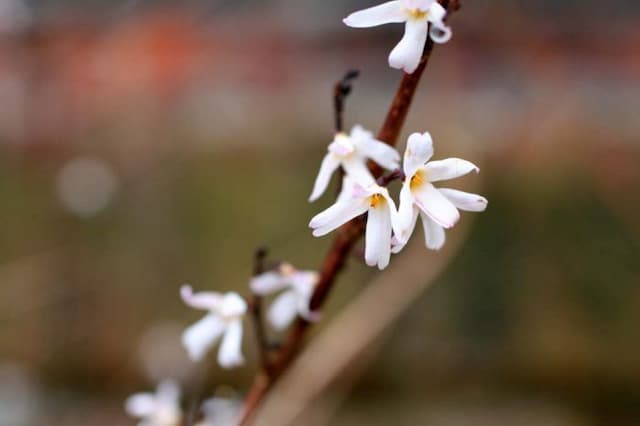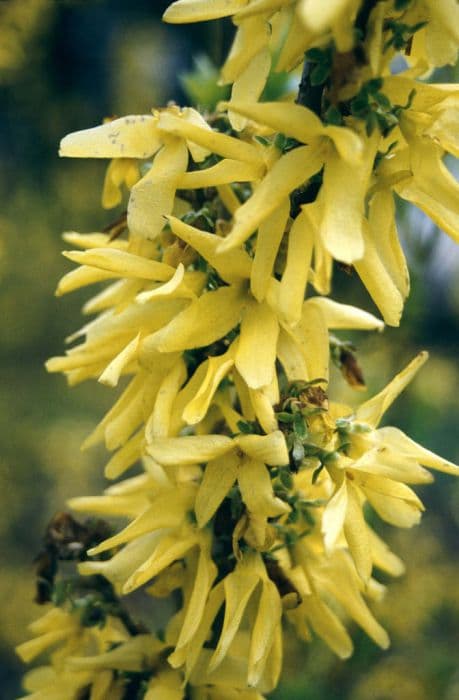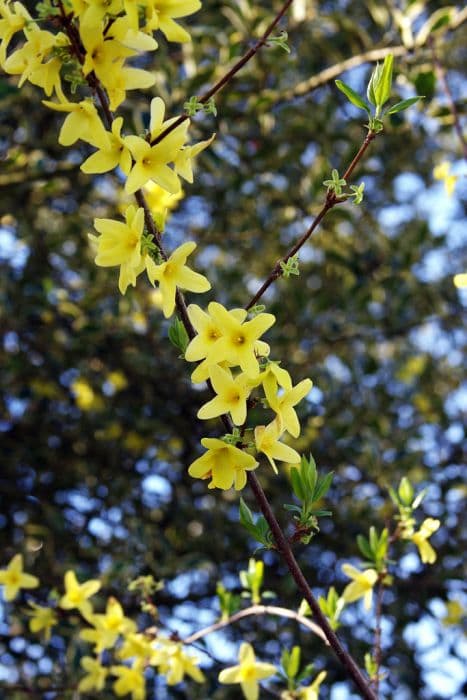Border forsythia Forsythia × intermedia 'Spring Glory'

ABOUT
Forsythia 'Spring Glory' is a deciduous shrub recognized for its vibrant display of bright yellow flowers that herald the arrival of spring. The flowers are bell-shaped and appear in profusion, covering the branches before the leaves unfurl. The blossoms are typically around 2-3 centimeters long and cluster around the woody stems. After flowering, the plant develops green foliage that consists of simple, opposite leaves, which are medium to dark green and can have a slightly serrated edge. Following the growing season, the leaves may turn to a yellowish or purplish color before they drop in the fall. The branches of Forsythia 'Spring Glory' are upright and arching, forming a rounded shape overall. The bark of mature stems is typically brown and may exfoliate slightly to reveal a lighter underbark. In winter, the bare stems maintain an appealing structure, with the promise of next year's blooms lying dormant in the buds that dot the branches.
About this plant
 Names
NamesFamily
Oleaceae.
Synonyms
Border Forsythia, Golden Bell, Spring Glory Forsythia.
Common names
Forsythia × intermedia 'Spring Glory'.
 Toxicity
ToxicityTo humans
Forsythia, including the variety 'Spring Glory', is not considered toxic to humans. There are no common symptoms of poisoning associated with the plant since it's generally recognized as safe. Ingesting parts of the plant is not known to have harmful consequences, but as with any non-food plant, it is not advisable to consume plant material that is not typically regarded as edible.
To pets
Forsythia, including the cultivar 'Spring Glory', is generally considered non-toxic to pets such as dogs and cats. It is not known to cause poisoning in pets, and therefore there are no common symptoms associated with its ingestion. While it is always best to prevent pets from eating non-food plants to avoid potential gastrointestinal upset, ingesting parts of the Forsythia 'Spring Glory' is unlikely to lead to serious consequences.
 Characteristics
CharacteristicsLife cycle
Perennials
Foliage type
Deciduous
Color of leaves
Green
Flower color
Yellow
Height
8-10 feet (2.4-3 meters)
Spread
10-12 feet (3-3.6 meters)
Plant type
Shrub
Hardiness zones
5-8
Native area
Europe Asia
Benefits
 General Benefits
General Benefits- Early Spring Blooms: Forsythia 'Spring Glory' is one of the first plants to flower in spring, providing a cheerful burst of yellow flowers when most other plants are still dormant.
- Landscape Ornamentation: The bright yellow flowers provide a striking visual interest in landscaping and can be used as a focal point in gardens.
- Erosion Control: Being a shrub with a robust root system, it can help stabilize the soil and prevent erosion on slopes and banks.
- Wildlife Attraction: The flowers provide nectar and the bushes may offer shelter for various types of wildlife, including birds and bees.
- Low Maintenance: Once established, Forsythia 'Spring Glory' requires minimal care, making it ideal for gardeners seeking low-maintenance landscaping options.
- Tolerance to a Variety of Conditions: It can tolerate a range of soil types, urban pollution, and is relatively resistant to both drought and freezing temperatures.
- Privacy Screen: Because Forsythia 'Spring Glory' grows thickly, it can be used as a natural privacy screen or hedge.
- Easy Propagation: The plant can be easily propagated from cuttings, allowing gardeners to create more plants for use in other areas or to share with friends.
 Medical Properties
Medical PropertiesThis plant is not used for medical purposes.
 Air-purifying Qualities
Air-purifying QualitiesThis plant is not specifically known for air purifying qualities.
 Other Uses
Other Uses- Forsythia branches can be forced to bloom indoors during winter to add color and a touch of spring to the interiors, simply by placing cut stems in water.
- The plant’s fast-growing nature makes it suitable for use in erosion control, helping to stabilize soil on slopes and embankments.
- Dried forsythia branches provide structural interest in floral arrangements and can be included in wreaths or other dried plant displays.
- The forsythia's dense growth habit can provide a natural privacy screen or windbreak when planted in rows or hedges.
- Planting forsythia near vegetable gardens can serve as a natural indicator of soil temperature; when it blooms, the soil is often warm enough to plant frost-sensitive crops.
- Forsythia wood is relatively hard and can be used in limited woodworking applications for small crafted items such as tool handles.
- With its bright yellows, forsythia flowers are sometimes used as natural dyes for fabrics and yarns.
- Children sometimes use hollowed forsythia stems to create natural whistles or simple wind instruments.
- Incorporating forsythia in landscape design can increase overall biodiversity, providing habitat and food for various insects and birds.
- Forsythia cuttings can serve an educational purpose in classrooms or home settings, demonstrating how plants can root and grow from cuttings.
Interesting Facts
 Feng Shui
Feng ShuiThe Forsythia is not used in Feng Shui practice.
 Zodiac Sign Compitability
Zodiac Sign CompitabilityThe Forsythia is not used in astrology practice.
 Plant Symbolism
Plant Symbolism- Anticipation: Forsythias, including 'Spring Glory', are often one of the first plants to bloom in spring, symbolizing the anticipation and the coming of warmer weather and longer days.
- Optimism: The bright yellow blooms of the forsythia are a cheerful sight after the gloomy winter, representing optimism and the hope for a joyful future.
- Renewal: As forsythia heralds the arrival of spring, it is associated with renewal and the idea of life beginning anew.
- Vitality: The vigorous growth and vibrant color of the forsythia blooms are symbols of vitality and the energetic burst of life that spring brings.
 Water
WaterThe Forsythia, commonly known as Golden Bell, should be watered deeply and thoroughly, allowing the soil to become moderately dry between waterings. During the first growing season, establish a deep root system by watering regularly, usually once a week or more often during extreme heat. An approximate guideline is to provide the plant with 1 inch of water per week, either through rainfall or manual watering, which equates to roughly 0.6 gallons for every square foot of soil. It's important to avoid overwatering, as Forsythia does not like to sit in soggy soil. Adjust the frequency of watering during winter when the plant is dormant, reducing it to account for slower soil moisture depletion.
 Light
LightGolden Bells thrive in full sun to partial shade conditions. For optimal flowering and growth, place the plant in a spot where it can receive at least six hours of direct sunlight daily. While Forsythia can tolerate some light shade, too much shade can result in fewer flowers and a leggier growth habit. Choose an area clear of buildings or tree cover to ensure it gets plenty of sunshine.
 Temperature
TemperatureGolden Bells are hardy and can withstand a range of temperatures, preferring temperate conditions. They can generally tolerate winter temperatures down to about -10°F and are comfortable in the heat up to around 90°F. Their ideal growing temperature is between 60°F and 75°F for optimal growth and flowering. It's crucial to protect the plant from extreme cold during the first few years until it's fully established.
 Pruning
PruningPrune Golden Bells immediately after they finish flowering in the spring, as they bloom on the previous year's growth. Pruning is done to maintain the bush's shape, remove any dead or damaged branches, and encourage the growth of new flower-bearing wood. It is often sufficient to prune yearly, though older plants may benefit from rejuvenation pruning every few years, which involves cutting the plant back to about a foot from the ground.
 Cleaning
CleaningAs needed
 Soil
SoilFor Forsythia, commonly known as the Border Forsythia, a well-draining loamy soil with a pH of 6.0 to 7.0 is best. A mix with organic matter like compost will enhance drainage and provide essential nutrients. It's important for the soil to retain some moisture but not stay soggy.
 Repotting
RepottingBorder Forsythia, which is typically grown as a shrub in gardens, doesn't require frequent repotting. It's generally planted directly in the ground where it can thrive for years without the need to be moved.
 Humidity & Misting
Humidity & MistingBorder Forsythia is not particularly humidity-sensitive and can thrive in average outdoor humidity levels. They are adaptable to the humidity found in most temperate regions.
 Suitable locations
Suitable locationsIndoor
Ensure bright light, well-draining soil, and room to grow.
Outdoor
Full sun, prune after flowering, well-draining soil.
Hardiness zone
5-8 USDA
 Life cycle
Life cycleForsythia × intermedia 'Spring Glory', more commonly known as Spring Glory Forsythia, starts its life cycle when the seeds germinate in spring to early summer after experiencing stratification. The seedlings then grow into young plants that will establish a root system and foliage, typically in a nursery setting. As the shrub matures, it undergoes a period of vigorous vegetative growth each year in the spring and summer, followed by a dormant phase in the fall and winter when it sheds leaves and conserves resources. Flowering occurs in early spring before the leaves fully emerge, showcasing bright yellow blossoms that attract pollinators. After pollination, the flowers develop into fruit capsules containing the seeds, which are then dispersed to start a new life cycle. Over the years, the shrub can be rejuvenated by pruning after flowering to maintain its shape and encourage more prolific blooming in the following season.
 Propogation
PropogationPropogation time
Spring
Forsythia × intermedia 'Spring Glory', commonly known as border forsythia, is most effectively propagated during the dormant season, generally in late fall or early winter just before the ground freezes, or in early spring just as the ground thaws. The most popular method of propagation for this plant is by taking softwood cuttings. This involves selecting healthy, new growth shoots that have not yet become woody. The cuttings, typically 4 to 6 inches long (about 10 to 15 centimeters), are taken from the current year's growth and should include several sets of leaves. The lower leaves are removed, and the cut end is dipped into rooting hormone to encourage root development. The prepared cutting is then planted in a pot containing a mixture of peat and perlite or sand to provide good drainage and kept moist but not waterlogged. Within a few weeks to a couple of months, the cuttings should develop roots and can eventually be transplanted outdoors.








